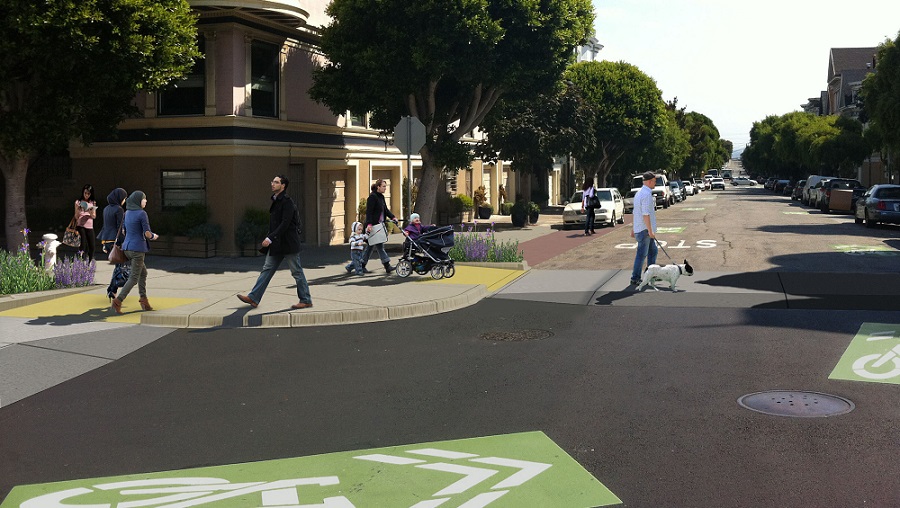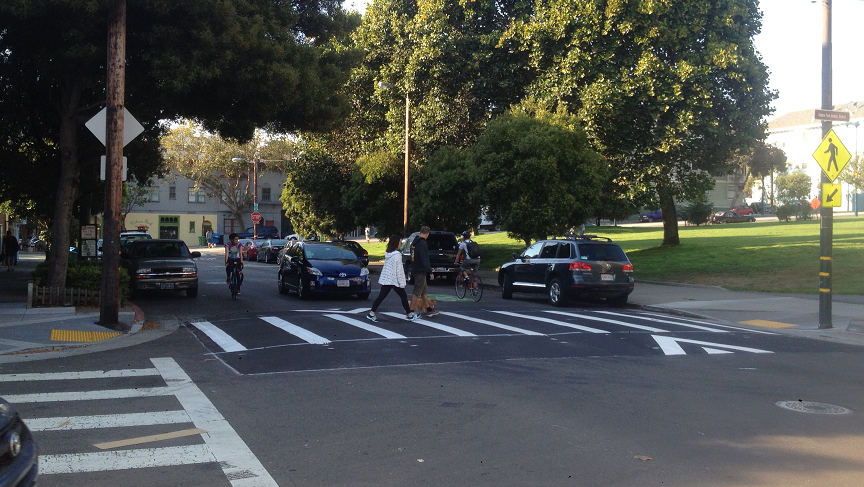
“Neighborway” projects will combine traffic-calming design features like raised crosswalks and sidewalk bulb-outs, like those seen in this rendering for the Wiggle Neighborhood Green Corridor Project.
Neighborhood streets should feel quiet, safe and inviting, especially to walk and bike to nearby destinations like parks, schools and shops. But residential streets often need design help to feel truly welcoming, especially if you’re taking kids along for the journey.
As laid out in our new Pedaling Forward document this week, we’re launching a new type of street design project called “neighborways.” Open houses for the first of these projects — on Page Street and 8th Avenue — will take place this Saturday and next week (more on those below).
Neighborway projects focus on improving residential streets by calming vehicle traffic, making them easier to navigate and friendlier for walking and biking. They will combine street design measures tailored to each neighborhood, including speed humps, traffic circles, crosswalk upgrades and restrictions on thru traffic.
With this initiative, we envision networks of safe and attractive residential streets that better connect neighbors with destinations – and each other – in their communities.
While the name of neighborways might sound new, the concept isn’t. Neighborways are residential streets designed to give priority for people, young and old, to walk, bike and play. Names for the idea may vary (you may have heard of “slow zones,”) but similar programs have been implemented in cities around North America like Boston and Somerville, Massachusetts; Seattle, Washington; and Louisville, Kentucky.
To design great neighborways, we plan to work with communities to see how we can best tailor engineering solutions, such as:
- Speed humps and raised crosswalks to help calm vehicle traffic
- “Wayfinding” pavement markings and street signs to help guide people walking and biking, with information on directions and distances to major destinations
- Traffic circles to help calm traffic at intersections
- More visible crosswalks and pedestrian islands to make crossing the street safer and more comfortable
- Sidewalk bulb-outs at street corners to slow turning vehicles and shorten the distance pedestrians have to cross
- Physical measures, in certain cases, to eliminate unsafe vehicle turns and/or reduce through traffic on neighborway streets

A raised crosswalk that also acts as a speed hump on Steiner at Hermann Street on the Wiggle.
To see the elements of a neighborway in action, look no further than the Wiggle – the route that zig-zags through the Lower Haight. Thanks to its relatively flat geography and the way traffic tends to route through the street grid, the Wiggle is naturally popular for walking and biking. We’ve added some neighborway-style improvements to the Wiggle in recent years, like raised crosswalks and green pavement markings to highlight priority for people on bikes. More extensive improvements are coming as part of the Wiggle Neighborhood Green Corridor Project.
Neighborways are ideal on routes that provide an attractive alternative to streets with heavy vehicle traffic. Many of these have already been identified as priority streets for walking and biking in city plans based on community input, such as the San Francisco Bike Network, the Green Connections Network and various neighborhood plans.
Our first two official neighborway projects will be on 8th Avenue in the Richmond District and Page Street in the Lower Haight/Hayes Valley area.
This weekend and next week, we’re hosting open houses for each project. If you can make it, please join us to learn about the projects and share your thoughts.
8th Avenue Neighborway Open House
Saturday, March 11, 1 p.m. to 3 p.m.
Richmond/Senator Milton Marks Branch Library
350 9th Avenue
Page Street Neighborway Open House
Wednesday, March 15, 6 – 7:30 p.m
John Muir Elementary School
380 Webster Street